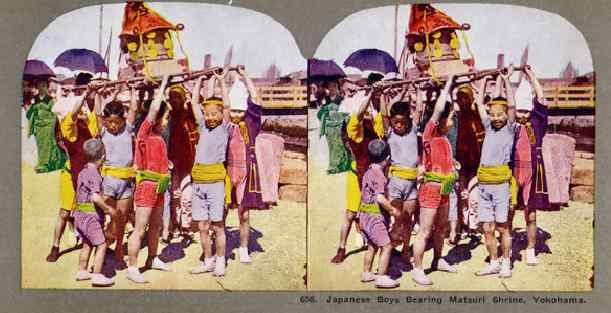
Japanese Boys' Clothes: Activities--Festival Chronology

Figure 1.-- The chronology of the various festivals held throughout Japan varies widely. Some of these festivals date from medieval times. Others are of more modern origins. We do not yet have any images of the early festivls. We do have some from the late 19th and early 20th century. These stereoscopic viewers were popular items in American homes before the advent of movies and mass media photo magazines. The caption reads, "608. Japanese boys bearing matsuri shrine, Yokahama." Notice how plain the costumes are. The scene here is undated, but we would guess was made in the late-1890s.
|
|
The chronology of the various festivals held throughout Japan varies widely. This reflects their varied origins. Some of these festivals date from medieval times. Others are of more modern origins. We do not yet have any images of the early festivls. Presumably there are some paintings depicting these early festivals. With the invention of photography we have some images dating from the late 19th century. At the time the early photographs were taken, most Japanese boys still wore traditional clothing. The early images we have found show that the modern festivals have preserved some of the same costumes although they seen fancier than those worn in 19th century festivals. We are not yet sure, however, as to what extent the modern costumes are accurate rebditions of the festival costumes worn in the middle ages. The affluence of modern Japan allows parents to splurge on costumes for their children participating in the festivals.
Medieval Era
The chronology of the various festivals held throughout Japan varies widely. This reflects their varied origins. Some of these festivals date from medieval times. We do not yet have any images of the early festivls. Presumably there are some paintings depicting these early festivals. We are not sure if children played as prominant a role in the medieval festivals as is the case in modern festivals.
The 19th Century
With the invention of photography we have some images dating from the late 19th century. At the time the early photographs were taken, most Japanese boys still wore traditional clothing. The early images we have found show that the modern festivals have preserved some of the same costumes. Notice that children were involved in the 19th century festivals, at least in the late 19th century (19th century).
These Japanese traditional festivals have continued to be popular in the 20th century. In fact they may have been even more popular in the 20th century as people have people can afford to clebrate more flmboyantly, especially after Workd War II. We seem to note fancier costumes than in the past, but still based on traditional styles. Here we only have a few 19th centuyry images for comparison. We are not yet sure, however, as to what extent the modern costumes are accurate rebditions of the festival costumes worn in the middle ages. Often in such feastivals modern styles or the desire for more involved costumes can affect the desire to have an historically correct costume. A factor here is that the children sometimes wear their regular clothes under their fetival clothes. The affluence of modern Japan allows parents to splurge on costumes for their children participating in the festivals. Children play a very important part role in 20th century festivals, although we do not true is that was as trure in the early 20th century.
HBC

Navigate the Boys' Historical Clothing Web Site:
[Introduction]
[Activities]
[Biographies]
[Chronology]
[Clothing styles]
[Countries]
[Bibliographies]
[Contributions]
[FAQs]
[Glossary]
[Images]
[Links]
[Registration]
[Tools]
[Boys' Clothing Home]
Navigate the Boys' Historical Clothing Japanese pages:
[Return to the Main Japanese festival page]
[Return to the Main Japanese page]
[Choirs]
[Department store catalogs]
[Monarchy]
[Music recitals]
[Youth groups]
[School uniforms]
Created: 3:11 AM 11/10/2006
Last updated: 5:11 PM 10/1/2008



